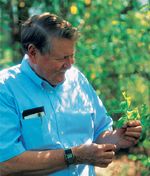 |
 |
||||||
|
|
|
|
|
I THINK THAT I SHALL NEVER SEE A POEM lovely as a tree . . . As an elementary school student, Don Smith, self- proclaimed lover of trees, won a blue ribbon for reciting this Joyce Kilmer poem. “I grew up in West Texas without many trees. I don’t take them for granted,” says the UNT associate professor of biological sciences. Today, Smith is helping to save the post oak — the Dallas-Fort Worth area’s predominant native tree —from death by insufficient water absorption.
The root of the problem The post oak, or Quercus stellata, thrives in warm climates from Texas to Georgia. Post oaks may grow up to 50 feet tall and 2 feet wide and may live 100 years or more. Yet most of these rugged trees are hypersensitive, reacting to any root system disturbance by slowing down production of root hairs. These single-cell extensions of epidermal cells are located on new roots smaller than a little finger. Root hairs live less than a month but absorb more than 95 percent of a tree’s water and minerals, Smith says. “Smaller roots are not necessarily more absorptive than larger roots, but they make up a large fraction of the total surface area available for absorption,” he says. “Very little absorption occurs in roots much more than an inch from the growing tip, so a tree must constantly produce new root hairs to thrive.” Smith says he first became aware of post oaks’ hypersensitivity a decade ago through his tree-trimming business. “I noticed that many trees located in new construction sites died within a few years. It was obvious that insufficient water reached the tips of limbs. People asked me why this happened, and I got tired of answering, ‘I don’t know,’” he says. “I decided to find an answer.” After ruling out irrigation system problems, Smith tried to discover if a parasite was destroying the trees’ roots. But the roots, even in dying trees, appeared healthy. He soon discovered that any disturbance to most post oaks’ root areas, such as a bulldozer driving across nearby ground or a new sidewalk being paved, resulted in slowed growth of new root hairs because of decreased production of new roots. “Botanists groan and say post oaks ‘don’t do well with civilization,’ which is accurate,” Smith says.
Signs of distress Almost any species of tree becomes somewhat distressed in construction areas, but most begin to thrive again soon after construction ceases, Smith says. However, approximately 80 percent of post oaks in construction sites die if their root growth is not stimulated, he adds. Smith says builders preserve these trees to provide highly desired shade in landscapes. “Prospective homebuilders pay thousands of extra dollars for lots with large, 50- to 100- year-old trees,” he says. These trees are impossible to replace in a lifetime, he adds. “You never see them in nurseries because they usually can’t be transplanted without dying,” he says. “You cannot replace post oaks unless you start with an acorn. Sadly, while trying to preserve and take advantage of the beauty and utility of these lovely trees, we are killing significant numbers each year.” Several signs point to a declining post oak, including thinning leaves. When a tree is in full foliage, “you should be able to stand under it, look up and not see any sky,” Smith says. The presence of water sprouts — twigs that grow out of the bark of a larger limb rather than from a joint on another twig — and less than 6 inches of annual growth on the tree’s twigs also indicate that a tree is unhealthy.
Tree therapy Smith stimulates root growth in ailing post oaks through a homemade treatment. Although early spring is the ideal time for fertilizing, Smith says it’s more important to fertilize healthy post oaks before, or soon after, nearby construction starts to ward off future slowdown of root growth. Unhealthy post oaks should be treated as soon as possible.“I actually get more calls during the summer because it’s then that people notice thinning leaves,” he says. Since developing the treatment, Smith has fertilized approximately 200 trees, including post oaks adjacent to the construction site for UNT’s new Gateway Center. He has an 80 percent success rate for saving trees. “When the tree dies despite my treatment, its energy reserves may have been too low to grow more roots, and the treatment, by stimulating production of new roots, hastened death by exhausting the meager food supply,” Smith says. He adds that when he has applied the treatment before or soon after the root area is disturbed, the trees almost never go into decline. Smith says he hopes his research will ultimately result in post oaks existing and thriving despite new construction. “Oaks are
easy to maintain, and they’re part of our culture. You see many
references to the strength of oaks in literature,” he says. “We
should do everything possible to preserve them.”
|
||||||||||

